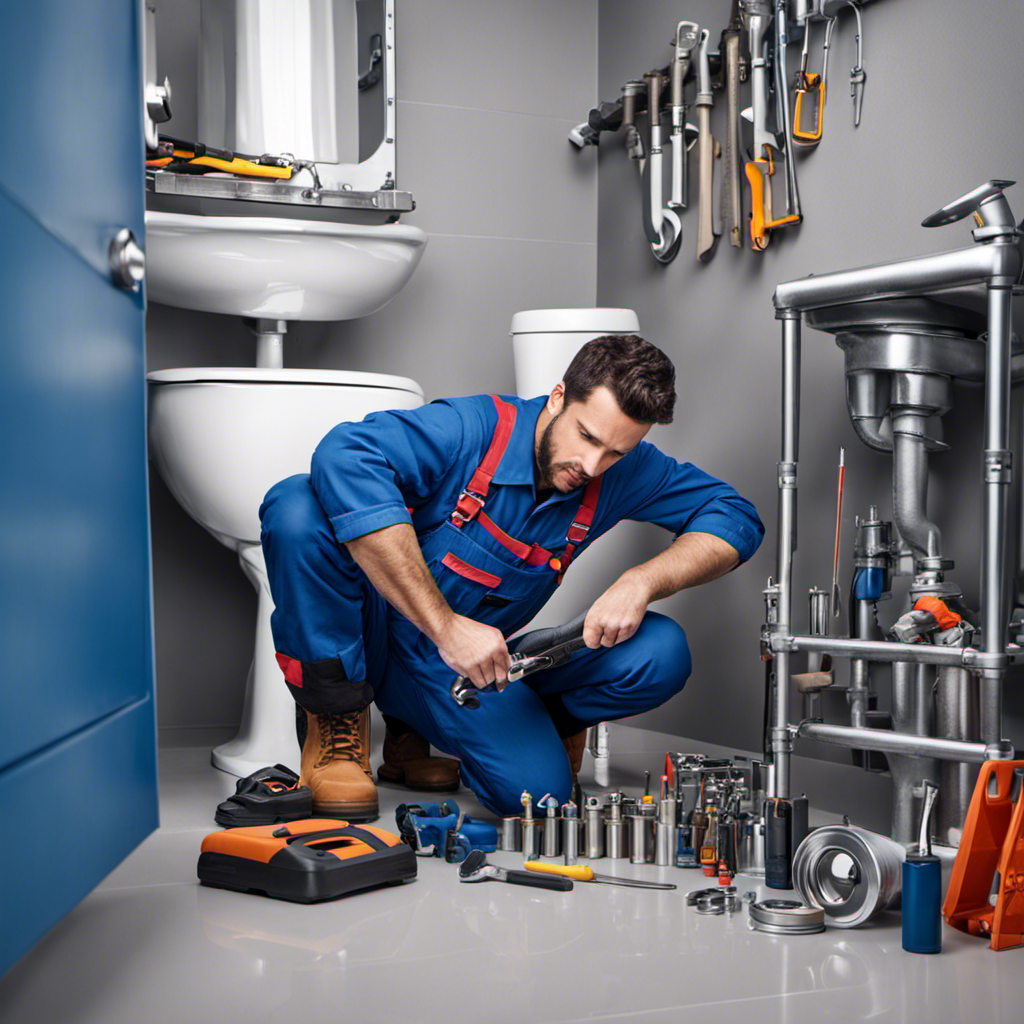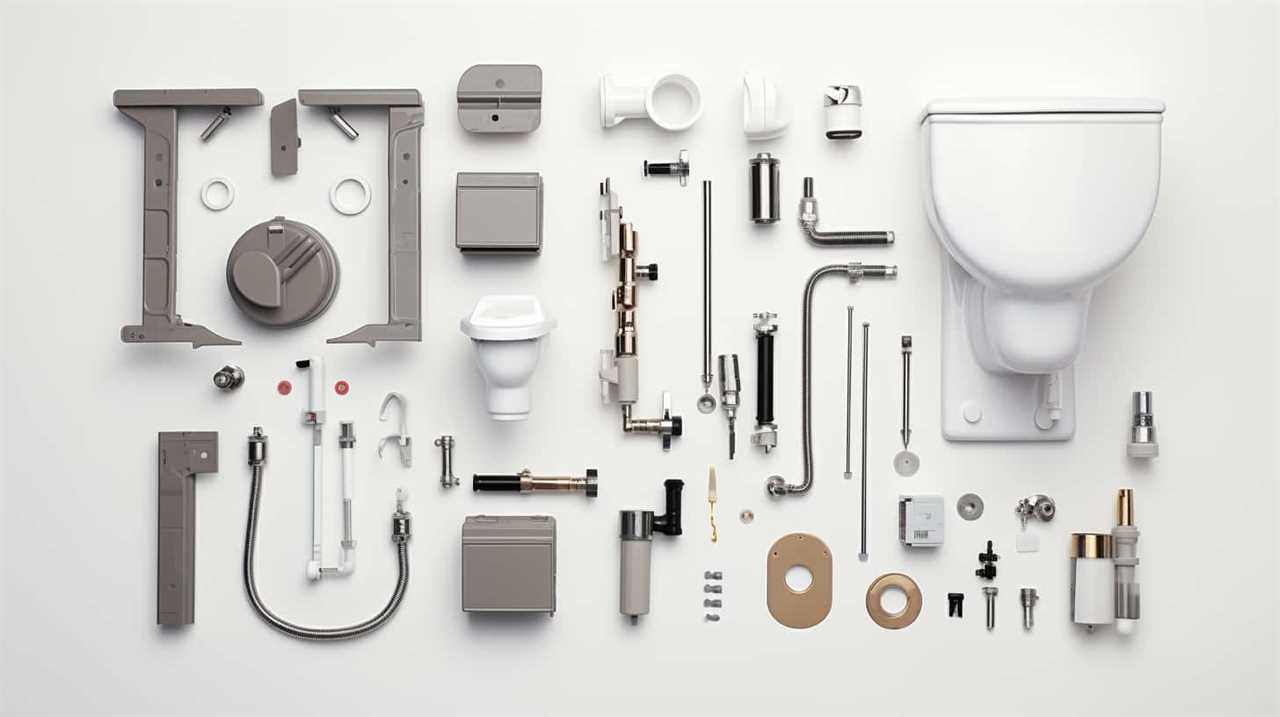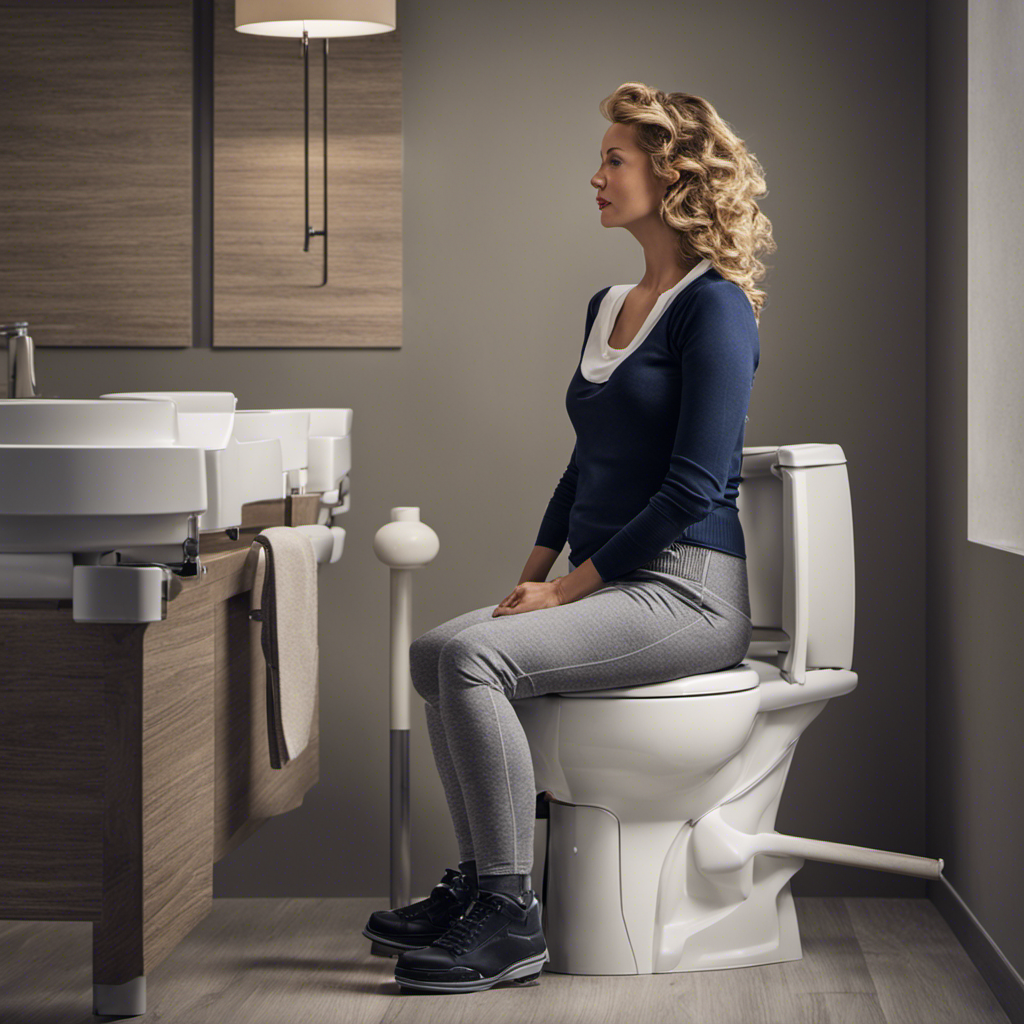Have you ever wondered how much it would cost to replace a toilet? Well, I’ve got all the answers for you right here.
In this article, I’ll be diving into the factors that affect the cost of toilet replacement, comparing the average cost of DIY versus hiring a professional, and discussing additional costs to consider.
We’ll also explore different brand and style options and their price range, as well as hidden expenses like plumbing and installation fees.
Plus, I’ll share some money-saving tips along the way.
So, let’s get started and make your toilet replacement journey a breeze!
Key Takeaways
- The cost of toilet replacement can vary depending on factors such as the type of toilet, complexity of installation, additional plumbing work required, and location.
- On average, the installation cost ranges from $200 to $500, with factors such as the type of toilet, location, and additional plumbing work affecting the cost.
- Hiring a professional plumber has benefits such as expertise, proper installation, and reduced risk of errors or damage, but DIY can be fulfilling and cost-saving if you have the necessary skills and time.
- To save costs, consider purchasing a gently used toilet, exploring salvage yards or online marketplaces for discounted options, looking for sales or promotions at home improvement stores, and gathering all necessary tools and materials before starting the project.
Factors Affecting the Cost of Toilet Replacement
The cost of replacing a toilet can vary depending on factors such as the type of toilet you want and the complexity of the installation process. When it comes to toilet replacement options, there are a few choices to consider.
You can opt for a standard gravity-fed toilet, which is the most common and affordable option. Alternatively, you could go for a pressure-assisted toilet, which provides a more powerful flush but tends to be more expensive. Another option is a dual-flush toilet, which allows you to choose between a full or partial flush, saving water in the process.
As for the toilet replacement time frame, it usually takes a professional plumber around 2 to 4 hours to complete the installation. However, this can vary depending on the complexity of the project and any additional plumbing work required.
Average Cost of Toilet Replacement
When it comes to replacing a toilet, there are several factors that can affect the cost. These factors include the type of toilet you choose, the complexity of the installation, and any additional plumbing work that may be required.
While some people may opt to replace the toilet themselves to save money, it is important to consider the potential risks and challenges involved. In this discussion, we will explore the factors that can affect the cost of toilet replacement, weigh the pros and cons of DIY versus hiring a professional, and provide some cost-saving tips for those looking to replace their toilet.
Factors Affecting Cost
To get an accurate cost estimate for replacing your toilet, you’ll need to consider a few factors. The average installation cost for a toilet replacement ranges from $200 to $500, depending on various factors such as the type of toilet, location, and additional plumbing work required. It is important to note that these costs are just estimates and can vary depending on your specific circumstances. The best time to replace a toilet is generally during the spring or fall when the weather is mild and there are no extreme temperature fluctuations. This ensures that the installation process goes smoothly and minimizes the risk of any complications. Additionally, scheduling the replacement during off-peak seasons may also result in lower overall costs.
| Factors Affecting Cost | ||
|---|---|---|
| Type of Toilet | Location | Additional Plumbing Work |
DIY Vs Professional
Hiring a professional for the job is usually more convenient and can ensure that the installation is done correctly. While DIY projects can be fulfilling and cost-saving, there are certain benefits to hiring a professional for toilet replacement.
First and foremost, professionals have the expertise and experience to handle the job efficiently and effectively. They are knowledgeable about the different types of toilets available and can help you choose the right one for your needs.
Additionally, professionals have the necessary tools and equipment to complete the installation properly, reducing the risk of errors or damage. By trusting a professional, you can have peace of mind knowing that the job is being done by someone with the skills and knowledge necessary.
Now, let’s explore some cost-saving tips for toilet replacement.
Cost-Saving Tips
If you’re looking to save money during your bathroom renovation, one cost-saving tip is to consider purchasing a gently used toilet instead of a brand new one. Used toilets can often be found at a significantly lower price, making them a budget-friendly option.
Here are some additional cost-cutting techniques to consider:
- Explore local salvage yards or online marketplaces for discounted or second-hand toilets.
- Consider purchasing a toilet that is a slightly older model or has minor cosmetic flaws, as these are often sold at a discounted price.
- Look for sales or promotions at home improvement stores, as they occasionally offer discounted prices on toilets.
Cost Comparison: DIY Vs Hiring a Professional
When it comes to replacing a toilet, there are several factors to consider.
First, there is the option of DIY, which can be a cost-effective choice. By doing the work yourself, you can save on labor costs. However, it’s important to weigh the potential risks and benefits.
On the other hand, hiring a professional ensures a high-quality installation and guarantees their work. This can provide peace of mind and save you from potential issues down the line.
Lastly, it’s essential to consider the time and effort required for a DIY project. Sometimes, a task may take longer and require more skill than initially anticipated.
DIY Cost Savings
You can save some money by doing the toilet replacement yourself. Here are some cost-saving techniques to consider:
-
Research and gather all the necessary tools and materials before starting the project. This will help avoid any additional trips to the hardware store.
-
Watch video tutorials or read step-by-step guides to ensure you understand the process and can confidently complete the replacement.
-
Take your time and follow the instructions carefully to prevent any mistakes or damage to the new toilet or plumbing.
-
When purchasing a new toilet, consider opting for a budget-friendly option that still meets your needs without breaking the bank.
-
Compare prices at different stores or online to find the best deals on toilets and replacement parts.
-
If you encounter any difficulties or feel unsure about certain steps, consult with a professional for guidance instead of risking costly mistakes.
Professional Quality Guarantee
For a professional quality guarantee, it’s essential to hire a licensed plumber to handle the installation. Hiring a professional ensures that you receive the highest level of expertise and experience.
When it comes to guarantee coverage, licensed plumbers offer peace of mind. They have the necessary skills and knowledge to install your new toilet correctly, ensuring that it functions properly and doesn’t cause any future issues.
Additionally, licensed plumbers often provide warranties for their work, which means that if any problems arise, they will fix them at no additional cost to you. Their professional expertise also ensures that the installation is done efficiently and safely, reducing the risk of accidents or damage to your property.
Time and Effort?
Hiring a licensed plumber can save you time and effort in the long run. When it comes to plumbing issues, it’s tempting to try and fix them yourself to save money. However, tackling complex plumbing problems without the necessary expertise can lead to even more time-consuming and costly repairs down the line.
Here are a few reasons why hiring a professional plumber is worth it:
-
Time management: A licensed plumber has the knowledge and experience to quickly diagnose and fix plumbing issues, saving you valuable time that could be spent on other important tasks.
-
Energy consumption: Plumbing problems, such as leaks or inefficient fixtures, can result in increased energy consumption. A professional plumber can identify and resolve these issues, helping you save on your energy bills.
Additional Costs to Consider When Replacing a Toilet
When replacing a toilet, it’s important to consider the additional costs involved. In addition to the cost of the new toilet itself, there are other expenses that you need to factor in.
One of these is the cost of additional materials. Depending on the condition of your bathroom floor or the plumbing connections, you may need to purchase extra supplies such as wax rings, bolts, or even new water supply lines. These materials can add to the overall cost of the replacement.
Another cost to consider is the labor fees. If you’re not confident in your DIY skills, hiring a professional plumber to install the new toilet is a wise choice. However, keep in mind that their fees can vary depending on the complexity of the job and your location.
Brand and Style Options and Their Price Range
There’s a wide range of brand and style options available, each with their own price range.
When it comes to brand options, some popular choices include Kohler, American Standard, and Toto. These brands are known for their quality and durability, but they also come with a higher price tag.
On the other hand, there are more affordable options like Glacier Bay and Mansfield, which offer good value for the price.
As for style options, you can choose between traditional, modern, and contemporary designs. Each style has its own unique features and aesthetics, allowing you to customize your toilet to fit your personal preferences and the overall look of your bathroom.
Whether you’re looking for a high-end brand or a budget-friendly option, there’s a brand and style out there for everyone.
Hidden Expenses: Plumbing and Installation Fees
Plumbing and installation fees can add to the overall cost of installing a new toilet. When replacing a toilet, it is important to consider these hidden expenses to avoid any surprises. In addition to the cost of the toilet itself, you may need to budget for professional plumbing services and installation. Plumbing emergencies can arise during the installation process, which can further increase the overall cost. It is always recommended to hire a licensed plumber to ensure a proper and safe installation.
To give you an idea of the potential costs, here is a breakdown of common plumbing and installation fees:
| Plumbing and Installation Fees | Average Cost |
|---|---|
| Service Call Fee | $50 – $100 |
| Toilet Removal and Disposal | $50 – $100 |
| New Toilet Installation | $150 – $250 |
| Additional Plumbing Work | Varies |
Tips for Saving Money on Toilet Replacement
To save money on installing a new toilet, you can consider these money-saving tips:
- Opt for toilet replacement alternatives:
- Consider refurbished toilets: These are pre-owned toilets that have been restored to their original condition. They are cheaper than brand new ones and still provide reliable performance.
- Look for discounted or clearance toilets: Many home improvement stores offer discounts on older models or floor samples. These toilets are often in perfect condition but are priced lower to make room for newer inventory.
- Explore online marketplaces: Websites like Craigslist or Facebook Marketplace often have used toilets for sale at a fraction of the cost of a new one.
Consider eco-friendly toilet options:
- Dual-flush toilets: These toilets have two flushing options, one for liquid waste and another for solid waste. They help conserve water by using less for liquid waste.
- Low-flow toilets: These toilets are designed to use less water per flush compared to traditional toilets, making them more environmentally friendly.
DIY installation: If you’re handy and have some plumbing experience, you can save money by installing the new toilet yourself. Just make sure to follow the manufacturer’s instructions and take all necessary safety precautions.
Frequently Asked Questions
What Are the Different Factors That Can Affect the Cost of Toilet Replacement?
Factors such as the type of toilet, additional features, installation complexity, and location can all contribute to cost differences when replacing a toilet. It’s important to consider these factors when budgeting for the project.
How Much Does It Typically Cost to Replace a Toilet?
Replacing a toilet can vary in cost depending on factors like the type of toilet, location, and additional repairs. It’s important to consider both the installation and repair costs when budgeting for a toilet replacement.
Should I Hire a Professional or Try to Replace the Toilet Myself? What Are the Cost Differences?
It’s important to consider the pros and cons of DIY vs professional installation when replacing a toilet. While doing it yourself can save money, hiring a professional ensures proper installation and avoids potential mistakes.
Are There Any Additional Costs to Consider When Replacing a Toilet?
When replacing a toilet, it’s important to consider potential hidden costs. From unexpected plumbing issues to the need for additional supplies, these expenses can quickly add up. It’s crucial to weigh the cost effectiveness of DIY versus hiring a professional.
What Are the Different Brand and Style Options Available for Toilets, and What Price Range Can I Expect?
When it comes to toilet brand comparison and style trends, there are plenty of options available. The price range can vary depending on the brand and style you choose.
Conclusion
In conclusion, replacing a toilet can be a costly endeavor. The average cost ranges from $200 to $800. However, hiring a professional for the job can save you time and ensure proper installation. Although it may come with additional fees.
One interesting statistic is that according to a survey, 45% of homeowners opt for a water-efficient toilet during replacement. This can save up to 13,000 gallons of water annually.
Considering all the factors and costs involved, it is important to carefully evaluate your options. Choose what works best for your budget and needs.










